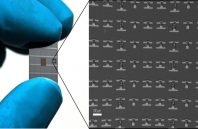Using novel nanofabrication techniques, researchers from the University of Pennsylvania and Cornell University have built micro-robots made from silicon and powered by solar cells. One million functional microscopic robots can be produced from a 4-in. silicon wafer.
The robots’ bodies are formed from a superthin rectangular skeleton of glass topped with a thin layer of silicon, into which the researchers have etched electronics control components and either two or four silicon solar cells. Each of a robot’s four legs is formed from a bilayer of platinum and titanium (or alternately, graphene). The platinum is applied using atomic layer deposition. The platinum-titanium layer is then cut into each leg.
The researchers shine a laser on one of a robot’s solar cells to power it. This causes the platinum in the leg to expand, while the titanium remains rigid, causing the limb to bend. The robot’s gait is generated when each solar cell causes the alternate contraction or relaxing of the front or back legs. The legs of the robots impose low power requirements yet can carry loads ten thousand times their own weight. Actuation only requires 200 mV signals, facilitating straightforward integration with silicon microelectronics, the researchers said.

 (585) 768-2513
(585) 768-2513

